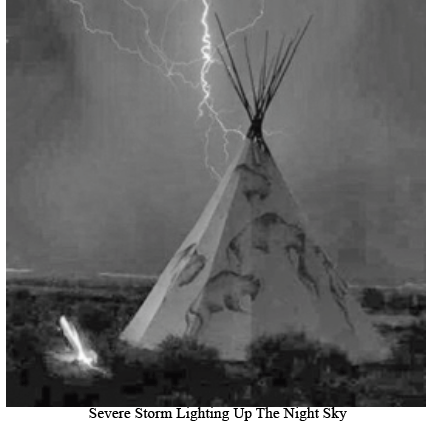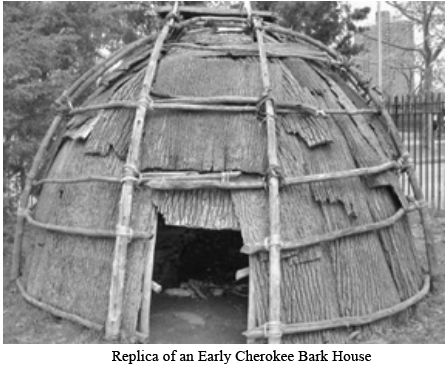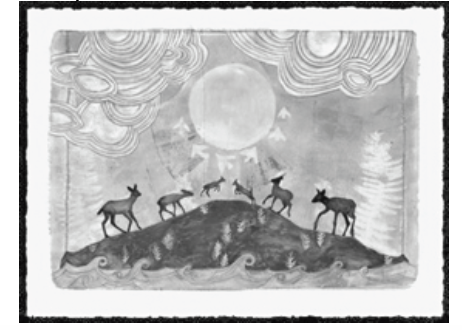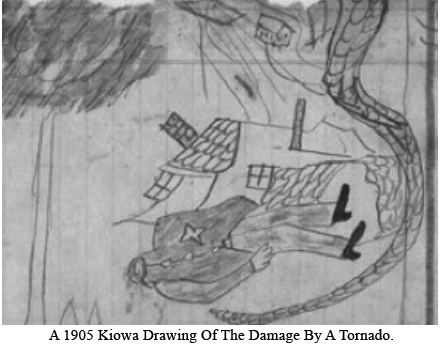
STORMS & TORNADOES
And The Indigenous Americans

With the seemingly unending storms and flooding because of them, I couldn’t help but wonder the way our indigenous Americans must have felt without the help of science to understand them. How unsettling it must have been with only bark houses, teepees, and other types of housing to protect them from the environment. I thought perhaps some of you might find the story an interesting one as well.
I know. I know… You are going to say that there are many different beliefs among the many different tribes of Indigenous Americans, and you would be correct with that assumption. So, due to my limited space, let me focus on the Cherokee, Seneca, and Deleware tribes since we all know, they were connected to this area, and directly referred to in West Virginia’s early history. (Full disclosure: My grandfather was half Cherokee and perhaps that fact does make me a bit bias.)

I have heard stories about traditions and beliefs of the Cherokee Nation and the Iroquois Nation (aka Six Nations which included the Mohawk, Oneida, Onondaga, Cayuga, Seneca, and the Tuscarora) my entire life. I used to sit for hours as a child and listen to every captivating word my grandmother relayed to me. She often spoke of the traditions of my family’s cures for sicknesses and diseases that were handed down through my grandfather’s family line as well as those of her own family. She was the great granddaughter of Phoebe Tucker Cunningham who was captured by the Wyandot Indians of Ohio. Her four young children killed in front of her.
One such tradition was that of “Thunder” or “Red Man” (Thunder itself) and his “Two Little Red Men” (Thunder’s two sons). Of course, thunder (or “ayvdaqualosgv” in the Cherokee language, pronounced “ay-ya-da-qua-lo-s-ga”) is usually associated with the lightning (a-na-ga-li-s-gv” pronounced “ah-na-ga-li-s-ga”) that precedes it. “Thunder,” is said to be dressed in lightning and rainbows, and legend says that he and his sons live in the land of the west above the sky vault.
When actual thunder erupts in heavy rolling crashes, the Cherokee say that it is the voice of “Thunder” himself. If the thunder is lighter, metallic peals of thunder, it is referred to as the sounds of the “Little Red Men,” or the sons of “Thunder.”
The Cherokee believed “Thunder” to be a friend to all Indigenous Americans, some still believe this. They cite that no Cherokee has ever been recorded being killed by “Thunder” (dressed in lightning), whereas white people have frequently been killed by it as well as scores of trees being struck every year by it.
The Thunder Spirit, like all spirits, had a specific roll to play, and it was to expel disease. He and his two sons were said to be the enemies of anything and anybody having their abode in the “Black Land,” in the “Evening Land,” in the “Dark Land,” or in the “West Land”.
Their “priests” prayed to “Thunder”, and he was said to visit the people to bring needed rain and blessings from the South. The Cherokee believed that Thunder beings lived close to the Earth’s surface in the cliffs, mountains, and waterfalls and could even harm the people at times should they choose to do so.

– A Drawing of the Cherokee “Galunlati” or Sky Vault.
Thunder did on occasion get angry, especially when he was referred to as “Red” in everyday language. The epithet (description) “Red” should only be bestowed on him in the ceremonial Cherokee language.
When referring to the “Two Little Red Men,” (never explicitly called “Thunder Boys”), they were said to always appear together. They were said to be about 60 centimeters high and wore a cap that was half red and half purple, surmounted by a peak. Some Cherokee still claim to have seen them or have heard them described as such.
So, did the early Cherokee Nation fear the thunder and lightning? It would appear not since they say no Indian has ever been reported to have been struck by the lightning preceding Thunder’s lightning.
Now… What about the tornado? How did they feel about them? In the Cherokee language, the word for tornado is “u-no-le” and pronounced “ooh-no-lay.” The rain that usually comes with the tornado is “a-ga-s-ga” in Cherokee and is pronounced “uh-gos-guh.”
Indigenous Americans believe the land talks to them and tells them when a tornado is coming. The leaves on the trees whisper warnings, flipping themselves over to the dark angry skies. The birds warn them when they stop their singing. The cattle and other livestock go to the farthest end of their fenced fields to escape from the fierce storm they know is coming. Most Indigenous Americans do not believe that tornadoes are evil. They believe that they reset the balance in nature.

Contrary to many beliefs that the Cherokee do not believe in one God, the Cherokee revere the Great Spirit (Unetlanvhi/Creator) who presides over and is creator of all things, including our beloved Mother Earth. The Wahnenauhi Manuscript states that God is “Unahlahnauhi,” in the Cherokee language, the Maker of All Things in English.
It is worth noting that according to “The Columbia Guide to American Indians of the Southeast” by Perdue and Green, the Cherokee people believe that we, as people, do not rule over the earth, plants, or animals. Instead, humanity coexists with all creations, and we, as people, are charged with the responsibility of mediation between all worlds to maintain balance.
Other interesting, but unrelated traditions:
If the pine tree has more pinecones at the top of the tree than elsewhere, it foretells of an unusually harsh winter. Another is that if animals have unusually thick fur, it foretells of a harsh winter. Many of us have heard the saying that if you see the backs of the leaves, it means rain is not far off, or a storm’s coming.
If the wind comes from the west, the bear has stretched his left arm in his winter bed. If the first thunder comes from the north, the bear has stretched his left leg in his winter bed. But if the first thunder comes from the south, the bear has stretched his right leg. If the first thunder comes from east, the bear has stretched his right arm and comes forth, and the winter is over.
Another one that many of us have heard most of our lives is: when the points of a new moon are up, most likely it means no rain will fall in that quarter of the moon. Never plant your crops when there is a halo around the moon.
We have our proud Indigenous Americans or original Americans to thank for much of our environmental wisdom. If not for their knowledge, generosity, and kindness, there was a good chance that our ancestors would not have survived, canceling all possibility that we would be here today. Is it not a truth worth pondering?
God Bless.
Patricia Richards Harris
Doddridge County Historical Society
